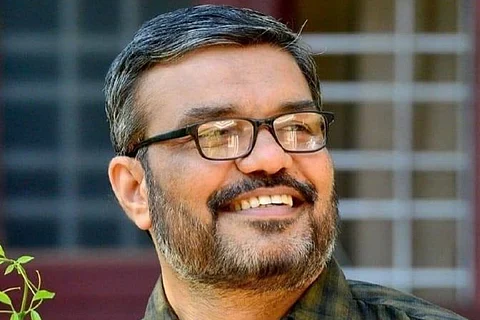

On May 28, the birth anniversary of Rashtriya Swayamsevak Sangh ideologue VD Savarkar, a sceptre was dug out from history and handed over to Prime Minister Narendra Modi to place in the new Parliament building — began a long Facebook note by MB Rajesh, Kerala’s Minister of Local Self Governments. His note, he said, was not meant to explain the ‘sceptre history’ that has been dismantled within a few hours of its emergence on ‘WhatsApp University’. It talked instead of the “dangerous political overtones of the Indian Prime Minister overriding the President who is the head of the nation and both Houses of Parliament under the Constitution, and installing himself as the highest office of the nation.”
Rajesh, who was earlier the Speaker of the Kerala Assembly, detailed the many implications that Sunday’s Parliament inauguration will have in the country. Beginning with the dominance of Narendra Modi as he overrode the President in the inauguration, Rajesh went on to associate the many changes brought on by the BJP as symbols of fascism. Modi’s dominance recalls a familiar slave phrase from the Emergency period of Prime Minister Indira Gandhi — “the country means Modi, Modi means the country,” Rajesh wrote.
The sceptre too, that Amit Shah (Home Minister) and Modi brought to the fore attains a big difference when it switches its location to the Parliament, Rajesh opined. Taken from the museum where India’s first Prime Minister Jawaharlal Nehru had kept it, the sceptre – a symbol of royal power – coming to the ‘new India after 2014’ is a rod of fascism falling on democracy, he said.
The Sangh Parivar, which dictates BJP’s Hindutva ideology, can claim no role in the freedom struggle and saw independence as a “mere ceremony of transfer of power,” in Rajesh’s words. He went on to add that it was not so for the crores of people who took part in the Indian National Movement, building a Constitution that guaranteed liberty, justice, equality, and fraternity.
“What the Constitution did was to make the people sovereign in independent India. If the sovereignty of the people is to be respected, what should be placed in the new Parliament is the famous preamble of the Constitution which begins with 'We the People,’ and not a sceptre,” Rajesh wrote.
The Sangh Parivar went in search of the sceptre to fulfil its failed dream in 1947 of winning power to form a Hindu Nation, he said, asking, “What else is the message of that sceptre, if not that of a fascist religious state that takes over the constitutional values and secular-democratic ideals of India?”
Rajesh also called attention to the protest of wrestlers that reached a pinnacle on Sunday when they were manhandled and detained by the police, outside the new Parliament building. Brij Bhushan Sharan Singh, the BJP MP and head of the Wrestling Federation of India who the protesters accuse of sexual harassment, had a seat inside the Parliament. All this symbolised the New India, Rajesh said.
Even the new sculpture of Lion Capital of Ashoka in Sarnath installed atop the Parliament is a world away from the peaceful ones that adorned the Ashoka pillar at Sarnath, Rajesh noted. “Every one of these symbols enforce the fascist logic of the regime. Otherwise, why would the inauguration ceremony of the Parliament be marked by yagna and yaga, defying the scientific awareness that the Constitution promotes,” he asked.
Along with the Parliament, a manufactured history was also being inaugurated, Rajesh said. Installing Savarkar’s image in the Central Hall when his vision opposed Gandhi’s is proof of that. One image of an accused (Savarkar) in the Gandhi assassination, he said, could not penetrate the great national movement symbolised by the Central Hall, the venue for the great debates of writing the Constitution, where the words of Nehru welcomed India to freedom and life while the rest of the world was sleeping, where Bhagat Singh's bombing exploded on the deaf ears of British power, where many brilliant moments of history were witnessed. That is why they were creating parallel history with a golden sceptre now, Rajesh wrote.
He also wondered why the new building has a Constitution Hall, when the historic Central Hall where the original constitution was made is right next door. “How is it possible in today's India not to suspect that it is not a foresight to build a new Constitution of a religion-based state to replace the Constitution of secular-democratic India? New citizenship law, new concept of nation based on religion, new constitution hall, new constitution, new manufactured history, new place names and above all, inauguration of new Parliament building on Savarkar's birth anniversary. There is a single supreme leader with a brand new rod of authority, with a sceptre. Now all that is left is coronation. Those who don't yet understand this must be naive. A new history of democracy's journey of death has begun,” he concluded.